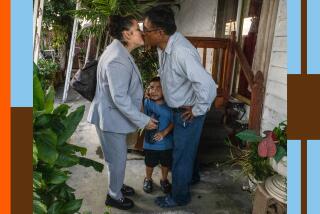I’m like a lot of the Latinos who’ve worked under the table. . . .
- Share via
Alex McCrae came to the United States from Canada in 1979 as an animator and has continued working in art and sculpture. This year, McCrae can’t go home for Christmas because of a law that will eventually give him permanent residency in the United States. McCrae lives in North Hollywood.
I’m going to miss going home to a white Christmas. I look forward to seeing my mom and brother and renewing old acquaintances in Toronto. I’ll have to give that up because I’m in the middle of this amnesty process. I’m not allowed to leave the country for four months, until I receive my temporary residency card in April.
My mother felt sad that I couldn’t come home for Christmas, but she and my brother came out in September for the unveiling of my two-piece sculpture in Beverly Hills. It sort of lessened the blow by our being together once this year.
I’m a little disturbed by it, but I feel that it’s a sacrifice that I’m willing to make. It’s important for me to become legal. The amnesty program assures me that I can work in the United States as long as I want to.
Right now I have a temporary work permit. I could leave as I have in the past, but if I were caught by the customs officials, it could jeopardize my whole amnesty thing, my ability to eventually obtain a green card. It could lead to deportation.
When I would go home for Christmas, I wouldn’t fly into Toronto. It was easier to have a friend or relative pick me up and drive through to Canada from Buffalo International Airport. Coming back was always real tense. I had some close calls but never got caught.
This year I started thinking about Christmas shortly after Thanksgiving. I didn’t want to spend Christmas on my lonesome, so to speak. I basically invited myself to join some very dear and close friends, Olof and Val Marneus in Los Gatos, in the lower Bay Area. These are very joyful people that I really resonate with. They’ve always been there when I’ve needed them. They opened their home to me throughout the summer of this past year and saw me through my last major sculpture project.
I remember the day the Immigration Reform and Control Act went through. I was elated. I heard it on the radio as I was going over to secure a base for one of my sculptures from a Latino base maker in North Hollywood. I mentioned that the bill had just been passed. I said, “Now I can finally become legal.” They laughed. They said, “You’re an alien? But you’re Canadian. You don’t need to go into this amnesty thing. You can work here, can’t you?” I guess they felt that way because I was not a visible minority.
I’m like a lot of the Latinos who’ve worked under the table, but being a Caucasian, I can pass very easily for an American. Since I was brought up in Toronto, we were tuned into the major networks. I grew up with Howdy Doody and Ed Sullivan.
The day of my interview at the INS was Oct. 1, the earthquake day. That was like the gods were against me. When I got to the INS office in the Wilshire and Alvarado area, there were throngs of amnesty candidates out in the parking lot and on the sidewalks. There was glass everywhere from windows that had broken in the building. Everybody was evacuated. So I was rescheduled and waited another month.
At my first appointment I was the only Caucasian among a hundred people. It was odd. One other Caucasian guy came into the room, and he sat right next to me. He was a real nervous type, and he sort of went into a meditative state. There were all of these Costa Ricans and Mexicans. I loved it. I like people, and it was fun just being there and looking at the different types. They looked at me like, “What’s he doing here?”
This country was built on immigrants. In a sense I feel it’s a special thing to be a part of it. I do have this feeling of wanting to pay back Canada. I was educated there and grew up there. I came here in my mid-30s. I just sense that I will show my art there or go back and teach when I’m older.
More to Read
Sign up for Essential California
The most important California stories and recommendations in your inbox every morning.
You may occasionally receive promotional content from the Los Angeles Times.













